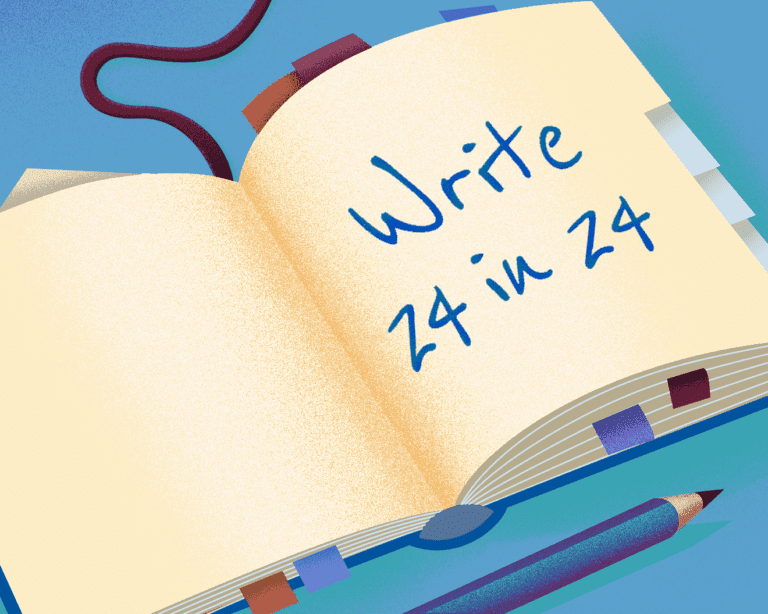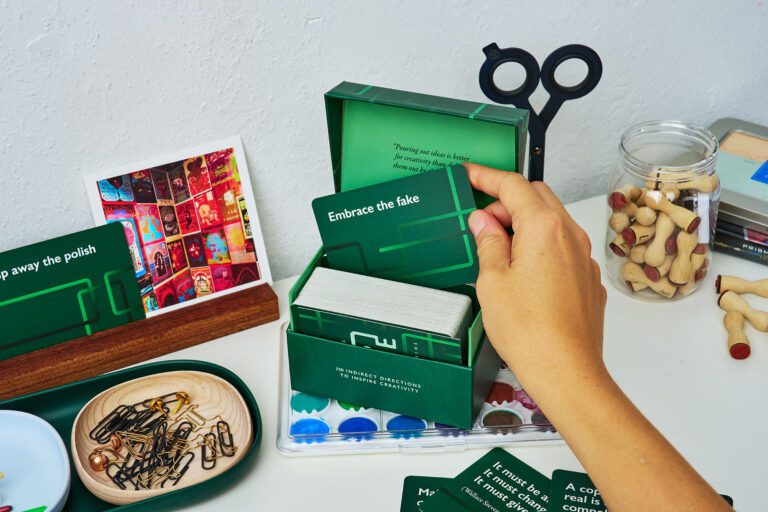For my upcoming book about the five senses—about how I’m trying to back inside my head by going through my body—I’ve been thinking a lot about the brain’s love of pattern and novelty.
I decided to boost my creativity by using indirect directions to help me discover solutions within myself—ones that I didn’t know I had.
To do this, I decided to create a set of creative commands—gnomic suggestions about how to tackle a tough creative challenge. Once I’ve finalized my list, I plan to make it into a deck of cards.
A few words can send my mind in a new direction; by shifting my perspective, and by imposing a stimulating constraint, these ideas help me to pull solutions out of my own mind.
I’ve already used many of these strategies at some point—or at least considered them, in a time of creative frustration. Many of them sound a bit peculiar, but they do work.
Here’s my current set of creative commands:
- Visit the junkyard or thrift store
- Improvise using what’s already in the closet
- Make a written list of the rules that apply
- Give yourself a looming deadline
- Combine clichés
- Add melodrama
- Bring the outside inside
- Bring the inside outside
- Miniaturize it
- Make it huge
- Turn it around
- Turn it upside down
- Eliminate the boring parts
- Create catch-phrases
- Make it rhyme
- Cut anything you’re not sure about
- Limit your resources
- Quiet mind
- Crank up the music, turn on the TV picture, and half-read a magazine while you work
- Make a concrete representation of an abstract idea
- Focus on structure
- Do everything all at once
- Change trying not to change
- Slow down
- Speed up
- Wait
- Now
- Work at 3:30 a.m.
- Design what’s for sale in the gift shop
- Change the logic of transitions
- Include water
- Include fire
- Include rocks
- Include plants
- Include mirrors
- Include clouds
- Include animals
- Introduce an explosion
- Incorporate something whole from the outside
- Return to the sandbox
- Buy new supplies
- Cut the budget in half
- Splurge on something excessive
- If you’re working on the package, limit yourself to the postage stamp
- If you’re working on the postage stamp, expand to work on the package
- Rearrange it
- Do something dangerous
- Just fix the obvious errors
- Hire someone
- Fire someone
- Does it include too many ideas?
- Recruit a volunteer
- Find a new boss
- Distort the proportions
- Fill every vase with flowers
- Add music
- Wear a costume
- Choose all
- Violate an important rule
- Reduce to a single element
- Remove all unnecessary words
- Add a ghost
- Add a wedding
- Add a battle
- Learn how to use a new tool
- Take a nap
- Visit a department store
- Ask for help
- Divide it into seven parts
- Strip away everything to the barest bones
- Ask myself, “What happens if I ignore this problem?”
- Ask myself, “What problem am I refusing to acknowledge?”
- Take a day off
- Work every day for a month
- Push something to the logical conclusion
- Instead of saying “Despite,” say “Because”
- Incorporate an element of chance
- Visit a museum and walk through every room
- Visit a museum and look at a single object
- Stop eating sugar
- No intoxicants
- Intoxicate yourself
- Close your eyes and listen
- If in the country, visit the city; if in the city, visit the country
- Set it in the past
- Set it in the future
- Foreshadow
- Speed up
- Slow down
- Add a note of vulgarity
- Describe it to someone who knows nothing about it
- Make something important ambiguous
- Add jokes
- Make it humorless
- Indulge the instinct that you usually suppress
- Make it ugly
- Make it pretty
- Add something purple or sparkly
- Submit to the discipline of a tradition
- Go swimming
- Make it louder
- Make it red
- Ask for help
- Is it interesting to a child?
- Protect only what is essential
- Eliminate something essential
- Look in the discard pile
- Review old notes
- Tell a story!
- Turn it into a cookbook recipe
- Add some disgust
- Fulfill a childhood vow
- If you can’t find something, clean up
- Look in the last place you had it
- Replace words with synonyms
- Replace words with antonyms
- Replace something important with an exact duplicate
- Take a photograph of it
- Indulge your secret desires
- Add classical allusions
- Re-read an old journal
- Add an element of randomness
- Eliminate everything arbitrary
- Made hidden elements visible
- Hide visible elements
- Add a serpent
- Shift the perspective
- Add more of what you’re good at
- Listen to your critics
- Ignore your critics
- Write your elevator pitch
- Shift the emphasis
- Find a fresh metaphor
- Submit to necessity
- Describe it to a friend who knows nothing about it
- Talk to yourself, out loud
- Turn it into a battle of good versus evil
- Incorporate a secret shame
- Look at it reflected in a mirror
- Anthropomorphize an important element
- Raise the stakes
- Lower the bar
- You already know what to do
Several of these were inspired by great artists or thinkers, such as Flannery O’Connor (“Turn it upside down”) as she describes in a letter of February 12, 1954, in The Habit of Being (Amazon, Bookshop); Andy Warhol (“Crank up the music, turn on the TV picture, and half-read a magazine while you work”) as he describes in POPism (Amazon, Bookshop); Picasso (“Start a romance”); St. Therese of Lisieux (“Choose all”); Robert De Niro and Martin Scorsese (“Submit to the discipline of a tradition”), as described in Scorsese on Scorsese (Amazon, Bookshop) (“De Niro…eventually persuaded Scorsese that they could both learn something from revisiting a traditional Hollywood genre and accepting its discipline.”)
“Add a ghost,” “add a wedding,” “add a battle” came from Robert Graves in Goodbye to All That (Amazon, Bookshop). (“I…deliberately mixed in all the ingredients that I know are mixed into other popular books…people like… reading about murders, so I was careful not to leave out any of the six or seven that I could tell about. Ghosts, of course…school episodes, love affairs (regular and irregular), wounds, weddings, religious doubts, methods of bringing up children, severe illnesses, suicides. But the best bet of all is battles.”)
Several were ideas suggested by friends. One of my college roommates told me about her commitment to “Eliminate the boring parts.” Another roommate was told by her thesis advisor, “You’re working on the package, you need to limit yourself to the postage stamp.”
And many of these come from my own experience. For instance, years ago, when I was first trying to get a literary agent, I showed a sample chapter to a brilliant agent who I hoped would represent me. She remarked that my writing contained “too many ideas.” At the time, I thought that she was talking nonsense; now I understand how right she was.
I can’t wait to turn these commands into a pack of cards. I love finding ways—even very simplistic ways—to make ideas concrete. (“Design what’s for sale in the gift shop.”)
What would you add? What would you subtract? This list is getting longer and longer.




